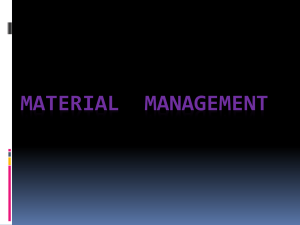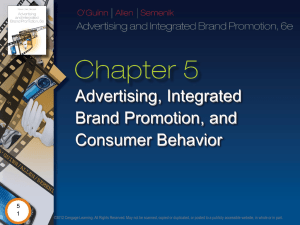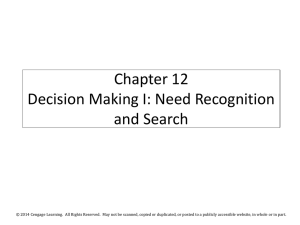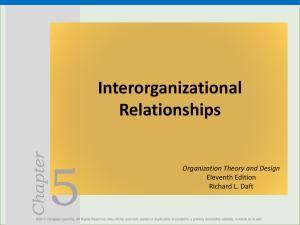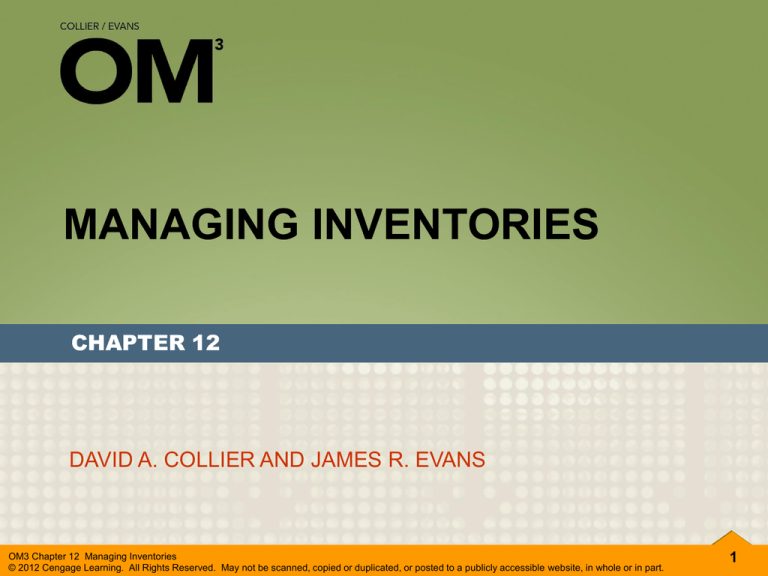
MANAGING INVENTORIES
CHAPTER 12
DAVID A. COLLIER AND JAMES R. EVANS
OM3 Chapter 12 Managing Inventories
© 2012 Cengage Learning. All Rights Reserved. May not be scanned, copied or duplicated, or posted to a publicly accessible website, in whole or in part.
1
CHAPTER 12
MANAGING INVENTORIES
LO1 Explain the importance of inventory, types of
inventories, and key decisions and costs.
LO2 Describe the major characteristics that impact
inventory decisions.
LO3 Describe how to conduct an ABC inventory analysis.
LO4 Explain how a fixed order quantity inventory
system operates, and how to use the EOQ and
safety stock models.
LO5 Explain how a fixed period inventory system
operates.
LO6 Describe how to apply the single period inventory
model.
OM3 Chapter 12 Managing Inventories
© 2012 Cengage Learning. All Rights Reserved. May not be scanned, copied or duplicated, or posted to a publicly accessible website, in whole or in part.
2
B
CHAPTER 12
MANAGING INVENTORIES
anana Republic is a unit of San Francisco’s Gap, Inc.
and accounts for about 13 percent of Gap’s sales. As Gap
shifted its product line to basics such as cropped pants,
jeans, and khakis, Banana Republic had to move away from
such staples and toward trends, trying to build a name for
itself in fashion circles. But fashion items, which have a
much shorter product life cycle and are riskier because their
demand is more variable and uncertain, bring up a host of
operations management issues. In one recent holiday
season, the company had bet that blue would be the topselling color in stretch merino wool sweaters. They were
wrong. Marka Hansen, company president noted, “The No.
1 seller was moss green. We didn’t have enough.”
OM3 Chapter 12 Managing Inventories
© 2012 Cengage Learning. All Rights Reserved. May not be scanned, copied or duplicated, or posted to a publicly accessible website, in whole or in part.
3
CHAPTER 12
MANAGING INVENTORIES
What do you think?
Can you cite any
experiences in which
the lack of appropriate
inventory at a retail
store has caused you
as the customer to be
dissatisfied?
OM3 Chapter 12 Managing Inventories
© 2012 Cengage Learning. All Rights Reserved. May not be scanned, copied or duplicated, or posted to a publicly accessible website, in whole or in part.
4
CHAPTER 12
MANAGING INVENTORIES
• Inventory is any asset held for future use or sale.
Objectives:
Maintain sufficient inventory
Incur lowest possible cost
• Inventory Management involves planning,
coordinating, and controlling the acquisition,
storage, handling, movement, distribution, and
possible sale of raw materials, component parts
and subassemblies, supplies and tools, replacement
parts, and other assets that are needed to meet
customer wants and needs.
OM3 Chapter 12 Managing Inventories
© 2012 Cengage Learning. All Rights Reserved. May not be scanned, copied or duplicated, or posted to a publicly accessible website, in whole or in part.
5
CHAPTER 12
MANAGING INVENTORIES
Understanding Inventory
• Raw materials, component parts,
subassemblies, and supplies are inputs to
manufacturing and service-delivery processes.
• Work-in-process (WIP) inventory consists of
partially finished products in various stages of
completion that are awaiting further processing.
• Finished goods inventory is completed products
ready for distribution or sale to customers.
• Safety stock inventory is an additional amount of
inventory that is kept over and above the average
amount required to meet demand.
OM3 Chapter 12 Managing Inventories
© 2012 Cengage Learning. All Rights Reserved. May not be scanned, copied or duplicated, or posted to a publicly accessible website, in whole or in part.
6
CHAPTER 12
MANAGING INVENTORIES
Exhibit 12.1 Role of Inventory in the Value Chain
OM3 Chapter 12 Managing Inventories
© 2012 Cengage Learning. All Rights Reserved. May not be scanned, copied or duplicated, or posted to a publicly accessible website, in whole or in part.
7
CHAPTER 12
MANAGING INVENTORIES
Inventory Management Decisions and Costs
Inventory managers deal with two fundamental
decisions:
1. When to order items from a supplier or when to
initiate production runs if the firm makes its own
items.
2. How much to order or produce each time a
supplier or production order is placed.
OM3 Chapter 12 Managing Inventories
© 2012 Cengage Learning. All Rights Reserved. May not be scanned, copied or duplicated, or posted to a publicly accessible website, in whole or in part.
8
CHAPTER 12
MANAGING INVENTORIES
Inventory Management Decisions and Costs
Four categories of inventory costs:
1. Ordering or setup costs
2. Inventory-holding costs
3. Shortage costs
4. Unit cost of the stock-keeping units (SKUs)
OM3 Chapter 12 Managing Inventories
© 2012 Cengage Learning. All Rights Reserved. May not be scanned, copied or duplicated, or posted to a publicly accessible website, in whole or in part.
9
CHAPTER 12
MANAGING INVENTORIES
Inventory Management Decisions & Costs
• Ordering costs or setup costs are incurred
as a result of the work involved in placing
purchase orders with suppliers or configuring
tools, equipment, and machines within a factory
to produce an item.
• Inventory-holding costs or inventory-
carrying costs are the expenses associated
with carrying inventory.
OM3 Chapter 12 Managing Inventories
© 2012 Cengage Learning. All Rights Reserved. May not be scanned, copied or duplicated, or posted to a publicly accessible website, in whole or in part.
10
CHAPTER 12
MANAGING INVENTORIES
Inventory Management Decisions & Costs
• Shortage costs or stockout costs are the
costs associated with a SKU being unavailable
when needed to meet demand.
• Unit cost is the price paid for purchased goods
or the internal cost of producing them.
OM3 Chapter 12 Managing Inventories
© 2012 Cengage Learning. All Rights Reserved. May not be scanned, copied or duplicated, or posted to a publicly accessible website, in whole or in part.
11
CHAPTER 12
MANAGING INVENTORIES
Inventory Characteristics
• Number of items: each item is identified by a
unique identifier, called a stock-keeping unit
(SKU).
A stock-keeping unit (SKU) is a single
item or asset stored at a particular location.
OM3 Chapter 12 Managing Inventories
© 2012 Cengage Learning. All Rights Reserved. May not be scanned, copied or duplicated, or posted to a publicly accessible website, in whole or in part.
12
CHAPTER 12
MANAGING INVENTORIES
Inventory Characteristics
Nature of Demand:
• Independent demand is demand for an SKU that
•
•
•
•
is unrelated to the demand for other SKUs and
needs to be forecast.
Dependent demand is demand directly related to
the demand for other SKUs and can be calculated
without needing to be forecast.
Demand can either be constant (deterministic) or
uncertain (stochastic).
Static demand is stable demand.
Dynamic demand varies over time.
OM3 Chapter 12 Managing Inventories
© 2012 Cengage Learning. All Rights Reserved. May not be scanned, copied or duplicated, or posted to a publicly accessible website, in whole or in part.
13
CHAPTER 12
MANAGING INVENTORIES
Inventory Characteristics
• Number and Duration of Time Periods:
Single period
Multiple time periods
• Lead Time:
The lead time is the time between
placement of an order and its receipt.
OM3 Chapter 12 Managing Inventories
© 2012 Cengage Learning. All Rights Reserved. May not be scanned, copied or duplicated, or posted to a publicly accessible website, in whole or in part.
14
CHAPTER 12
MANAGING INVENTORIES
Inventory Characteristics
• Stockouts:
A stockout is the inability to satisfy demand
for an item.
A backorder occurs when a customer is
willing to wait for an item.
A lost sale occurs when the customer is
unwilling to wait and purchases the item
elsewhere.
OM3 Chapter 12 Managing Inventories
© 2012 Cengage Learning. All Rights Reserved. May not be scanned, copied or duplicated, or posted to a publicly accessible website, in whole or in part.
15
CHAPTER 12
MANAGING INVENTORIES
OM3 Chapter 12 Managing Inventories
© 2012 Cengage Learning. All Rights Reserved. May not be scanned, copied or duplicated, or posted to a publicly accessible website, in whole or in part.
16
CHAPTER 12
MANAGING INVENTORIES
ABC Inventory Analysis
ABC inventory analysis categorizes SKUs into three
groups according to their total annual dollar usage.
1. “A” items account for a large dollar value but a
relatively small percentage of total items.
2. “C” items account for a small dollar value but a
large percentage of total items.
3. “B” items are between A and C.
OM3 Chapter 12 Managing Inventories
© 2012 Cengage Learning. All Rights Reserved. May not be scanned, copied or duplicated, or posted to a publicly accessible website, in whole or in part.
17
CHAPTER 12
MANAGING INVENTORIES
ABC Inventory (Pareto) Analysis
• “A” items account for a large dollar value but
relatively small percentage of total items (e.g., 10%
to 30 % of items, yet 60% to 80% of total dollar
value).
• “C” items account for a small dollar value but a
large percentage of total items (e.g., 50% to 60%
of items, yet about 5% to 15% of total dollar
value). These can be managed using automated
computer systems.
• “B” items are between A and C.
OM3 Chapter 12 Managing Inventories
© 2012 Cengage Learning. All Rights Reserved. May not be scanned, copied or duplicated, or posted to a publicly accessible website, in whole or in part.
18
CHAPTER 12
MANAGING INVENTORIES
Solved Problem
The data shows projected
annual dollar usage for 20
items. Exhibit 12.3 shows the
data sorted, and indicates that
about 70% of total dollar usage
is accounted for by the first 5
items.
Exhibit 12.2
Usage-Cost Data for
20 Inventoried Items
OM3 Chapter 12 Managing Inventories
© 2012 Cengage Learning. All Rights Reserved. May not be scanned, copied or duplicated, or posted to a publicly accessible website, in whole or in part.
19
CHAPTER 12
MANAGING INVENTORIES
Exhibit 12.3 ABC Analysis Calculations
OM3 Chapter 12 Managing Inventories
© 2012 Cengage Learning. All Rights Reserved. May not be scanned, copied or duplicated, or posted to a publicly accessible website, in whole or in part.
20
CHAPTER 12
MANAGING INVENTORIES
Exhibit 12.4 ABC Histogram for the Results from Exhibit 12.3
OM3 Chapter 12 Managing Inventories
© 2012 Cengage Learning. All Rights Reserved. May not be scanned, copied or duplicated, or posted to a publicly accessible website, in whole or in part.
21
CHAPTER 12
MANAGING INVENTORIES
Managing Fixed Quantity Inventory Systems
• In a fixed quantity system (FQS), the order
quantity or lot size is fixed; the same amount,
Q, is ordered every time.
The fixed order (lot) size, Q, can be a box,
pallet, container, or truck load.
Q does not have to be economically
determined, as we will do for the EOQ
model later.
OM3 Chapter 12 Managing Inventories
© 2012 Cengage Learning. All Rights Reserved. May not be scanned, copied or duplicated, or posted to a publicly accessible website, in whole or in part.
22
CHAPTER 12
MANAGING INVENTORIES
Managing Fixed Quantity Inventory Systems
• The process of triggering an order is based on
the inventory position.
• Inventory position (IP) is the on-hand
quantity (OH) plus any orders placed but which
have not arrived (scheduled receipts, or SR),
minus any backorders (BO).
IP = OH + SR – BO
[12.1]
OM3 Chapter 12 Managing Inventories
© 2012 Cengage Learning. All Rights Reserved. May not be scanned, copied or duplicated, or posted to a publicly accessible website, in whole or in part.
23
CHAPTER 12
MANAGING INVENTORIES
Managing Fixed Quantity Inventory Systems
• When inventory falls at or below a certain value,
r, called the reorder point, a new order is
placed.
The reorder point is the value of the
inventory position that triggers a new order.
OM3 Chapter 12 Managing Inventories
© 2012 Cengage Learning. All Rights Reserved. May not be scanned, copied or duplicated, or posted to a publicly accessible website, in whole or in part.
24
CHAPTER 12
MANAGING INVENTORIES
Exhibit 12.5 Summary of Fixed Quantity System (FQS)
OM3 Chapter 12 Managing Inventories
© 2012 Cengage Learning. All Rights Reserved. May not be scanned, copied or duplicated, or posted to a publicly accessible website, in whole or in part.
25
CHAPTER 12
MANAGING INVENTORIES
Exhibit 12.6 Fixed Quantity System (FQS) under Stable Demand
OM3 Chapter 12 Managing Inventories
© 2012 Cengage Learning. All Rights Reserved. May not be scanned, copied or duplicated, or posted to a publicly accessible website, in whole or in part.
26
CHAPTER 12
MANAGING INVENTORIES
Exhibit 12.7 Fixed Quantity System (FQS) with Highly Variable Demand
OM3 Chapter 12 Managing Inventories
© 2012 Cengage Learning. All Rights Reserved. May not be scanned, copied or duplicated, or posted to a publicly accessible website, in whole or in part.
27
CHAPTER 12
MANAGING INVENTORIES
The EOQ Model
• The Economic Order Quantity (EOQ) model
is a classic economic model developed in the
early 1900s that minimizes total cost, which is
the sum of the inventory-holding cost and the
ordering cost.
OM3 Chapter 12 Managing Inventories
© 2012 Cengage Learning. All Rights Reserved. May not be scanned, copied or duplicated, or posted to a publicly accessible website, in whole or in part.
28
CHAPTER 12
MANAGING INVENTORIES
The EOQ Model
Assumptions:
• Only a single item (SKU) is considered.
• The entire order quantity (Q) arrives in the
inventory at one time.
• Only two types of costs are relevant—
order/setup and inventory holding costs.
• No stockouts are allowed.
• The demand for the item is deterministic and
continuous over time.
• Lead time is constant.
OM3 Chapter 12 Managing Inventories
© 2012 Cengage Learning. All Rights Reserved. May not be scanned, copied or duplicated, or posted to a publicly accessible website, in whole or in part.
29
CHAPTER 12
MANAGING INVENTORIES
The EOQ Model
• Cycle inventory (also called order or lot
size inventory) is inventory that results
from purchasing or producing in larger lots
than are needed for immediate consumption
or sale.
Average cycle inventory = (Maximum inventory +
Minimum inventory)/2
= Q/2
OM3 Chapter 12 Managing Inventories
© 2012 Cengage Learning. All Rights Reserved. May not be scanned, copied or duplicated, or posted to a publicly accessible website, in whole or in part.
[12.2]
30
CHAPTER 12
MANAGING INVENTORIES
Exhibit 12.8 Cycle Inventory Pattern for the EOQ Model
OM3 Chapter 12 Managing Inventories
© 2012 Cengage Learning. All Rights Reserved. May not be scanned, copied or duplicated, or posted to a publicly accessible website, in whole or in part.
31
CHAPTER 12
MANAGING INVENTORIES
The EOQ Model
Inventory Holding Cost
The cost of storing one unit in inventory for the
year, Ch, is:
Ch = (I)(C)
[12.3]
Where:
I = Annual inventory-holding charge expressed as a
percent of unit cost.
C = Unit cost of the inventory item or SKU.
OM3 Chapter 12 Managing Inventories
© 2012 Cengage Learning. All Rights Reserved. May not be scanned, copied or duplicated, or posted to a publicly accessible website, in whole or in part.
32
CHAPTER 12
MANAGING INVENTORIES
The EOQ Model
Annual inventory-holding cost is computed as:
annual inventory
holding cost =
(
)(
average
inventory
)
annual holding
cost per unit
1
= 2 QCh
OM3 Chapter 12 Managing Inventories
© 2012 Cengage Learning. All Rights Reserved. May not be scanned, copied or duplicated, or posted to a publicly accessible website, in whole or in part.
[12.4]
33
CHAPTER 12
MANAGING INVENTORIES
The EOQ Model
Ordering Cost
If D = Annual demand and we order Q units each
time, then we place D/Q orders/year.
Annual ordering cost is computed as:
annual
=
ordering cost
(
)(
number of
orders per year
) ()
cost
per order
=
D
Q
Co
[12.5]
Where C0 is the cost of placing one order.
OM3 Chapter 12 Managing Inventories
© 2012 Cengage Learning. All Rights Reserved. May not be scanned, copied or duplicated, or posted to a publicly accessible website, in whole or in part.
34
CHAPTER 12
MANAGING INVENTORIES
The EOQ Model
Total Annual Cost
Total annual cost is the sum of the inventory
holding cost plus the order or setup cost:
1
D
Co
TC = QCh +
Q
2
[12.6]
OM3 Chapter 12 Managing Inventories
© 2012 Cengage Learning. All Rights Reserved. May not be scanned, copied or duplicated, or posted to a publicly accessible website, in whole or in part.
35
CHAPTER 12
MANAGING INVENTORIES
The EOQ Model
Economic Order Quantity
The EOQ is the order quantity that minimizes the
total annual cost:
Q* =
√
2DCo
Ch
[12.7]
OM3 Chapter 12 Managing Inventories
© 2012 Cengage Learning. All Rights Reserved. May not be scanned, copied or duplicated, or posted to a publicly accessible website, in whole or in part.
36
CHAPTER 12
MANAGING INVENTORIES
The EOQ Model
Calculating the Reorder Point
The reorder point, r, depends on the lead time
and demand rate.
Multiply the fixed demand rate d by the length of
the lead time L (making sure they are expressed
in the same units, e.g., days or months):
r = Lead time demand
= (demand rate)(lead time)
= (d)(L)
[12.8]
OM3 Chapter 12 Managing Inventories
© 2012 Cengage Learning. All Rights Reserved. May not be scanned, copied or duplicated, or posted to a publicly accessible website, in whole or in part.
37
CHAPTER 12
MANAGING INVENTORIES
Solved Problem
D = 24,000 cases per year.
Co = $38.00 per order.
I = 18 percent.
C = $12.00 per case.
Ch = IC = $2.16.
24,000
1
TC = Q ($2.16) +
($38.00)
Q
2
EOQ =
√
2(24,000)(38) = 919 cases rounded
2.16
to a whole number.
OM3 Chapter 12 Managing Inventories
© 2012 Cengage Learning. All Rights Reserved. May not be scanned, copied or duplicated, or posted to a publicly accessible website, in whole or in part.
38
CHAPTER 12
MANAGING INVENTORIES
Exhibit 12.9 Chart of Holding, Ordering, and Total Costs
OM3 Chapter 12 Managing Inventories
© 2012 Cengage Learning. All Rights Reserved. May not be scanned, copied or duplicated, or posted to a publicly accessible website, in whole or in part.
39
CHAPTER 12
MANAGING INVENTORIES
Safety Stock and Uncertain Demand in a Fixed
Order Quantity System
• When demand is uncertain, using EOQ based on
the average demand will result in a high
probability of a stockout.
– Safety stock is additional planned on-hand
inventory that acts as a buffer to reduce the risk
of a stockout.
– A service level is the desired probability of not
having a stockout during a lead-time period.
OM3 Chapter 12 Managing Inventories
© 2012 Cengage Learning. All Rights Reserved. May not be scanned, copied or duplicated, or posted to a publicly accessible website, in whole or in part.
40
CHAPTER 12
MANAGING INVENTORIES
OM3 Chapter 12 Managing Inventories
© 2012 Cengage Learning. All Rights Reserved. May not be scanned, copied or duplicated, or posted to a publicly accessible website, in whole or in part.
41
CHAPTER 12
MANAGING INVENTORIES
Safety Stock and Uncertain Demand in a Fixed
Order Quantity System
When a normal probability distribution provides a good
approximation of lead time demand, the general expression
for reorder point is:
r = mL + zsL
[12.9]
Where:
mL = Average demand during the lead time.
sL = Standard deviation of demand during the lead time.
z = The number of standard deviations necessary to achieve
the acceptable service level.
“zsL” represents the amount of safety stock.
OM3 Chapter 12 Managing Inventories
© 2012 Cengage Learning. All Rights Reserved. May not be scanned, copied or duplicated, or posted to a publicly accessible website, in whole or in part.
42
CHAPTER 12
MANAGING INVENTORIES
Safety Stock and Uncertain Demand in a Fixed
Order Quantity System
We may not know the mean and standard deviation of
demand during the lead time, but only for some other length
of time, t, such as a month or year. Suppose that mt and st
are the mean and standard deviation of demand for some
time interval t. If the distributions of demand for all time
intervals are identical to and independent of each other,
then:
mL = mtL
[12.10]
s L = st √L
[12.11]
OM3 Chapter 12 Managing Inventories
© 2012 Cengage Learning. All Rights Reserved. May not be scanned, copied or duplicated, or posted to a publicly accessible website, in whole or in part.
43
CHAPTER 12
MANAGING INVENTORIES
Solved Problem
Southern Office Supplies, Inc. distributes laser printer
paper.
•
•
•
•
•
•
Ordering costs are $45.00 per order.
One ream of paper costs $3.80.
Annual inventory-holding cost rate is 20%.
The average annual demand is 15,000 reams, or about
15,000/52 = 288.5 per week.
The standard deviation of weekly demand is about 71.
The lead time from the manufacturer is two weeks.
Inventory-holding cost is Ch = IC = 0.20($3.80) =
$0.76 per ream per year.
OM3 Chapter 12 Managing Inventories
© 2012 Cengage Learning. All Rights Reserved. May not be scanned, copied or duplicated, or posted to a publicly accessible website, in whole or in part.
44
CHAPTER 12
MANAGING INVENTORIES
Solved Problem
• The average demand during the lead time is
(288.5)(2) = 577 reams.
• The standard deviation of demand during the
lead time is approximately 71√2 = 100
reams.
• The EOQ model results in an order quantity of
1333, reorder point of 577, and total annual
cost of $1,012.92.
OM3 Chapter 12 Managing Inventories
© 2012 Cengage Learning. All Rights Reserved. May not be scanned, copied or duplicated, or posted to a publicly accessible website, in whole or in part.
45
CHAPTER 12
MANAGING INVENTORIES
Solved Problem
•
Desired service level of 95%, which results in a
stockout of roughly once every 2 years. For a normal
distribution, this corresponds to a standard normal
z-value of 1.645.
r = mL + zsL = 577 = 1.645(100) = 742 reams
•
•
This policy increases the reorder point by 742 – 577 =
165 reams, which represents the safety stock.
The cost of the additional safety stock is Ch times the
amount of safety stock, or ($0.76/ream)(165 reams) =
$125.40.
OM3 Chapter 12 Managing Inventories
© 2012 Cengage Learning. All Rights Reserved. May not be scanned, copied or duplicated, or posted to a publicly accessible website, in whole or in part.
46
CHAPTER 12
MANAGING INVENTORIES
EOQ and Sustainability Practices
• Commonly hidden in inventory management decisions are
the costs to dispose of obsolete, hazardous materials.
• Environmental considerations, material losses, and waste
disposal can be included in the EOQ model to improve
inventory decisions.
• If a company examines its hazardous waste disposals and
observed that some percentage of its material is eventually
disposed of instead of used, then the company should
incorporate this into their inventory decisions.
• Example: Annual demand for paint is 4000 lbs., item cost is
$3/lb., order cost is $50, inventory-holding cost rate is 10%,
5% of paint is not sold and eventually disposed of, and the
disposal cost is $1/lb.
OM3 Chapter 12 Managing Inventories
© 2012 Cengage Learning. All Rights Reserved. May not be scanned, copied or duplicated, or posted to a publicly accessible website, in whole or in part.
47
CHAPTER 12
MANAGING INVENTORIES
EOQ and Sustainability Practices
• Disposal costs, on a per unit basis, can be
comparable to the initial item costs.
• For example, knowing that 5% of the paint is
disposed of, then the inventory-holding should be
calculated as:
Ch = [(10%)($3/lb. item cost)]
+ [(5% of paint disposed of)($1/lb. disposal cost)]
= $0.35/lb./year
OM3 Chapter 12 Managing Inventories
© 2012 Cengage Learning. All Rights Reserved. May not be scanned, copied or duplicated, or posted to a publicly accessible website, in whole or in part.
48
CHAPTER 12
MANAGING INVENTORIES
Managing Fixed Period Inventory Systems
• An alternative to a fixed order quantity system is a
fixed period system (FPS)—sometimes called a
periodic review system—in which the inventory
position is checked only at fixed intervals of time, T,
rather than on a continuous basis.
Two principal decisions in a FPS:
1. The time interval between reviews (T), and
2. The replenishment level (M)
OM3 Chapter 12 Managing Inventories
© 2012 Cengage Learning. All Rights Reserved. May not be scanned, copied or duplicated, or posted to a publicly accessible website, in whole or in part.
49
CHAPTER 12
MANAGING INVENTORIES
Managing Fixed Period Inventory Systems
Economic time interval:
T = Q*/D
[12.12]
Optimal replenishment level without safety stock:
M = d (T + L)
[12.13]
Where:
d = Average demand per time period.
L = Lead time in the same time units.
M = Demand during the lead time plus review period.
OM3 Chapter 12 Managing Inventories
© 2012 Cengage Learning. All Rights Reserved. May not be scanned, copied or duplicated, or posted to a publicly accessible website, in whole or in part.
50
CHAPTER 12
MANAGING INVENTORIES
Exhibit 12.10 Summary of Fixed Period Inventory Systems
OM3 Chapter 12 Managing Inventories
© 2012 Cengage Learning. All Rights Reserved. May not be scanned, copied or duplicated, or posted to a publicly accessible website, in whole or in part.
51
CHAPTER 12
MANAGING INVENTORIES
Exhibit 12.11 Operation of a Fixed Period Systems (FPS)
OM3 Chapter 12 Managing Inventories
© 2012 Cengage Learning. All Rights Reserved. May not be scanned, copied or duplicated, or posted to a publicly accessible website, in whole or in part.
52
CHAPTER 12
MANAGING INVENTORIES
Managing Fixed Period Inventory Systems
Uncertain Demand
• Compute safety stock over the period T + L.
• The replenishment level is computed as:
M = mT+L + zσT+L
[12.14]
mT+L = mt (T + L)
[12.15]
σT+L = σt √T + L
[12.16]
OM3 Chapter 12 Managing Inventories
© 2012 Cengage Learning. All Rights Reserved. May not be scanned, copied or duplicated, or posted to a publicly accessible website, in whole or in part.
53
CHAPTER 12
MANAGING INVENTORIES
Single-Period Inventory Model
• Applies to inventory situations in which one order
is placed for a good in anticipation of a future
selling season where demand is uncertain.
• At the end of the period, the product has either
sold out or there is a surplus of unsold items to
sell for a salvage value.
• Sometimes called a newsvendor problem,
because newspaper sales are a typical example.
OM3 Chapter 12 Managing Inventories
© 2012 Cengage Learning. All Rights Reserved. May not be scanned, copied or duplicated, or posted to a publicly accessible website, in whole or in part.
54
CHAPTER 12
MANAGING INVENTORIES
Single-Period Inventory Model
•
•
Solve using marginal economic analysis.
cs = The cost per item of overestimating demand
(salvage cost); this cost represents the loss of
ordering one additional item and finding that it cannot
be sold.
cu = The cost per item of underestimating demand
(shortage cost); this cost represents the opportunity
loss of not ordering one additional item and finding
that it could have been sold.
The optimal order quantity Q* must satisfy:
P (demand ≤ Q*) =
cu
cu + cs
[12.17]
OM3 Chapter 12 Managing Inventories
© 2012 Cengage Learning. All Rights Reserved. May not be scanned, copied or duplicated, or posted to a publicly accessible website, in whole or in part.
55
CHAPTER 12
MANAGING INVENTORIES
Solved Problem
•
•
•
•
•
A buyer orders fashion swimwear about six months
before the summer season.
Each piece costs $40 and sells for $60.
At the sale price of $30, it is expected that any
remaining stock can be sold during the August sale.
The cost per item of overestimating demand is equal to
the purchase cost per item minus the August sale price
per item: cs = $40 – $30 = $10.
The per-item cost of underestimating demand is the
difference between the regular selling price per item
and the purchase cost per item; that is, cu = $60 – $40
= $20.
OM3 Chapter 12 Managing Inventories
© 2012 Cengage Learning. All Rights Reserved. May not be scanned, copied or duplicated, or posted to a publicly accessible website, in whole or in part.
56
CHAPTER 12
MANAGING INVENTORIES
Solved Problem
Assume that a uniform probability distribution ranging
from 350 to 650 items describes the demand.
Exhibit 12.12 Probability Distribution for Single Period Model
OM3 Chapter 12 Managing Inventories
© 2012 Cengage Learning. All Rights Reserved. May not be scanned, copied or duplicated, or posted to a publicly accessible website, in whole or in part.
57
CHAPTER 12
MANAGING INVENTORIES
Solved Problem
The optimal order size Q must satisfy:
P (demand ≤ Q*) = cu /(cu + cs)
= 20/(20+10) = 2/3
Because the demand distribution is uniform, the
value of Q* is two-thirds of the way from 350 to
650. This results in Q* = 550.
OM3 Chapter 12 Managing Inventories
© 2012 Cengage Learning. All Rights Reserved. May not be scanned, copied or duplicated, or posted to a publicly accessible website, in whole or in part.
58
CHAPTER 12
MANAGING INVENTORIES
There’s More to Inventory Modeling
Quantitative models have been developed for other practical
situations:
• Backorder Models: It may be desirable from an economic
point of view to plan for and allow shortages, such as when
the value per unit of the inventory is very high, and hence
the inventory-holding cost is high (a new-car dealer’s
inventory). Most customers do not find the specific car they
want in stock, but are willing to backorder it.
• Quantity Discount Models: Suppliers often offer
discounts for purchasing larger quantities of goods. This
often occurs because of economies of scale associated with
larger quantities or simply as an incentive to increase total
revenue.
OM3 Chapter 12 Managing Inventories
© 2012 Cengage Learning. All Rights Reserved. May not be scanned, copied or duplicated, or posted to a publicly accessible website, in whole or in part.
59
CHAPTER 12
MANAGING INVENTORIES
Hardy Hospital Case Study
1. What are good estimates of order cost and
inventory holding cost? (State all assumptions and
show all computations.)
2. What is the EOQ and reorder point for Strike
Disinfectant given your answer to Question 1?
3. Compute the total order and inventory holding costs
for a Fixed Quantity System (FQS) and compare to
their current order Q's. Can you save money by
adopting a FQS?
4. What are your final recommendations? Clearly
explain your reasoning.
OM3 Chapter 12 Managing Inventories
© 2012 Cengage Learning. All Rights Reserved. May not be scanned, copied or duplicated, or posted to a publicly accessible website, in whole or in part.
60


